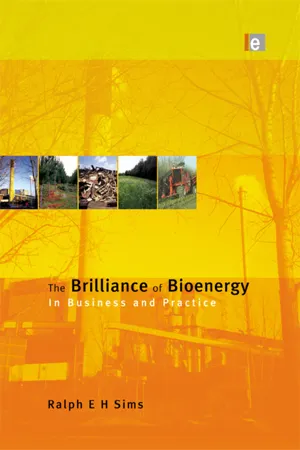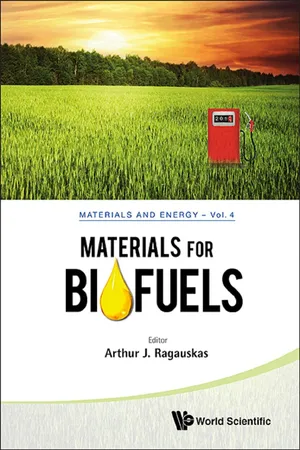Biological Sciences
Biomass
Biomass refers to organic materials, such as plants, wood, and agricultural waste, that can be used as a renewable energy source. It can be converted into biofuels, such as ethanol and biodiesel, and used for heating and electricity generation. Biomass is considered a sustainable energy option because it can be replenished through natural processes.
Written by Perlego with AI-assistance
Related key terms
4 Key excerpts on "Biomass"
- eBook - ePub
The Brilliance of Bioenergy
In Business and In Practice
- Ralph E H Sims(Author)
- 2013(Publication Date)
- Routledge(Publisher)
At the smaller domestic and village community scale, Biomass also has good potential as a fuel for micro-turbines and fuel cells (Chapter 10). In all cases environmental issues are key factors, and can be dealt with by developing good practice guidelines and understanding life cycle analysis. A range of socio-economic benefits will also result, particularly at the smaller scale. There seems little doubt that Biomass will provide an increasing share of the global primary energy supply, and that in the future new and more efficient bioenergy technologies will continue to be developed (Chapter 11). In the words of Professor David Hall, one of the pioneers of modern bioenergy who sadly died in late 1999 prior to his vision being fulfilled: ‘Biomass is forever.’ So what is Biomass? From a renewable energy perspective, Biomass can be defined as: recent organic matter originally derived from plants as a result of the photosynthetic conversion process, or from animals, and which is destined to be utilized as a store of chemical energy to provide heat, electricity, or transport fuels. Biomass resources include wood from sustainably grown plantation forests, residues from agricultural or forest production and organic waste by-products from food and fibre industries, domesticated animals and human activities. The chemical energy contained in the Biomass is derived from solar energy using the process of photosynthesis (based on the Greek photo, implying to do with light, and synthesis, the linking together of several parts). Photosynthesis is the process by which plants take in carbon dioxide and water from their surroundings and, using energy from sunlight, convert them into sugars, starches, cellulose, lignin etc. These components of vegetable matter are loosely termed carbohydrates, shown chemically for simplicity as [CH 2 O] - eBook - ePub
Biomass Gasification and Pyrolysis
Practical Design and Theory
- Prabir Basu(Author)
- 2010(Publication Date)
- Academic Press(Publisher)
Chapter 2. Biomass Characteristics2.1. IntroductionThe characteristics of Biomass greatly influence the performance of a Biomass gasifier. A proper understanding of the physical and the chemical properties of Biomass feedstock is essential for the design of a Biomass gasifier to be reliable. This chapter discusses some important properties of Biomass that are relevant to gasification and related processes.2.2. What Is Biomass?Biomass refers to any organic materials that are derived from plants or animals (Loppinet-Serani et al., 2008 ). A generally accepted definition is difficult to find. However, the one used by the United Nations Framework Convention on Climate Change (UNFCCC, 2005 ) is relevant here:[A] non-fossilized and biodegradable organic material originating from plants, animals and micro-organisms. This shall also include products, by-products, residues and waste from agriculture, forestry and related industries as well as the non-fossilized and biodegradable organic fractions of industrial and municipal wastes.Biomass also includes gases and liquids recovered from the decomposition of nonfossilized and biodegradable organic materials. In the United States, there has been much debate on a legal definition. Appendix A gives a recent legal interpretation of renewable Biomass.As a sustainable and renewable energy resource, Biomass is constantly being formed by the interaction of CO2 , air, water, soil, and sunlight with plants and animals. After an organism dies, microorganisms break down Biomass into elementary constituent parts like H2 O, CO2 , and its potential energy. Because the carbon dioxide, a Biomass releases through the action of microorganisms or combustion was absorbed by it in the recent past, Biomass combustion does not increase the total CO2 inventory of the Earth. It is thus called greenhouse gas neutral or GHG neutral.Biomass includes only living and recently dead biological species that can be used as fuel or in chemical production. It does not include organic materials that over many millions of years have been transformed by geological processes into substances such as coal or petroleum. Biomass comes from botanical (plant species) or biological (animal waste or carcass) sources, or from a combination of these. Common sources of Biomass are:• Agricultural: - eBook - ePub
Energy and the New Reality 2
Carbon-free Energy Supply
- L. D. Danny Harvey(Author)
- 2010(Publication Date)
- Routledge(Publisher)
4 Biomass Energy 4.1 IntroductionThe term ‘Biomass’ refers to plant materials that were produced recently enough through the process of photosynthesis, using energy from the sun, that they are still present in unaltered form. Fossil fuels are Biomass that has been transformed by chemical or thermo-chemical processes at elevated temperature and pressure after burial, and represent stored solar energy that accumulated over periods of millions of years.Primary Biomass energy can take a number of forms and can be transformed into secondary energy by a large number of different processes. In developing countries, Biomass supplied about 16 per cent of total primary energy demand in 2005 according to data in Volume 1, Table 2.2 (40EJ out of 251EJ), largely as wood and wood waste, agricultural waste and animal dung. This energy is largely used for cooking, but at very low efficiency (10–20 per cent) and with very high pollutant emissions. In developed countries, Biomass supplied about 3.5 per cent of total primary energy demand in 2005 – 8.2EJ out of 232EJ (Volume 1, Table 2.1 ). Globally, Biomass provided 10 per cent of total primary energy demand in 2005 (48 out of 483EJ).Figure 4.1 gives an estimate of the breakdown of Biomass energy use in 2007 for traditional Biomass uses (for heating and cooking) and for commercial energy uses as part of the market economy. The latter includes Biomass used to generate electricity, to produce heat (in wood-burning stoves, industrial boilers or for district heating systems) and to produce biofuels (ethanol and biodiesel). Figure 4.2 gives an estimate of the amount of Biomass used worldwide from 1900 to 2000, broken down by end use (domestic and industrial), source (fuelwood, crops, dung and charcoal) and by region. The uncertainty in the total Biomass use indicated in Figure 4.2 a is quite large. A large amount of Biomass is used in the pulp and paper industry, where forestry residues and Biomass wastes are used to produce some of the electricity and heat needed by the pulp and paper facilities (see Volume 1, Chapter 6 - eBook - ePub
- Arthur J Ragauskas(Author)
- 2014(Publication Date)
- WSPC(Publisher)
However, these three main issues are not the only stimuli: Biomass is also an indigenous energy source, available in most countries and its application may diversify the fuel-supply in many situations, which in turn may lead to a more secure energy supply. Biomass production can generate employment and if intensive agriculture is replaced by less intensively managed energy crops, there are likely to be environmental benefits, like reduced leaching of fertilizers and reduced use of pesticides. Moreover, if appropriate crops are selected, restoration of degraded lands may be possible. Depending on the crops used and the way the Biomass is cultivated, increased biodiversity can be obtained, compared to current agricultural practice.Biomass is available on a renewable basis, either through natural processes, or it can be made available as a by-product of human activities i.e., organic wastes. The potential of Biomass energy derived from forest and agricultural residues worldwide is estimated to be about 30 EJ/yr, compared to an annual world-wide energy demand of over 400 EJ. If Biomass is to contribute to a larger extent to the world’s energy supply, then energy farming, the cultivation of dedicated crops for energy purposes, will be required, using fallow land and marginal lands where the latter are largely unsuited for food crops. When energy crops are considered to be sources of Biomass, the total energy potential of Biomass for energy production may be considerably larger than the energy potential of Biomass residues. In 1992 at the Rio United Nations Conference on environment and development, the renewable intensive global energy scenario (RIGES) suggested that, by 2050, approximately half the world’s current primary energy consumption of about 400 EJ/yr, could be met by Biomass so that 60% of the world’s electricity market could be supplied by renewables, of which Biomass is a significant component.7Biomass can be converted into three main types of products: •electrical/heat energy •transport fuel •chemical feedstock Of particular interest in this chapter is the generation of transport biofuel or bio-ethanol, the other two end-products are to be discussed in the future studies.3. Biomass TypesLignocellulosic Biomasses were generally grouped into six categories, namely;8•energy crops •agricultural residues •logging residues •mill residues •forest resources •urban wastesOther feedstocks reported by some studies, such as aquatic plants and manures, are not the focus of this chapter. The energy crop category includes lignocellulosic crops grown to be converted to energy, such as herbaceous crops (e.g., switchgrass) and short rotation woody crops (e.g., hybrid poplar, willow). The agricultural residue category consists of the lignocellulosic portions of the plant remaining after primary harvest. Lignocellulosic Biomass originating from the forest is disaggregated into three categories by different sources and operations from which the Biomass originates. The first two categories are comprised of residues produced by industry. Logging residues are generated from forest management and harvesting activities.0 Other removals such as downed stock or those from cultural and land-clearing operations are also included in this category, because these materials are commonly grouped together in the studies, or, because they could not be disaggregated from logging residues. Mill residues are produced by wood processing operations and include primary and secondary mill residues, as well as pulping residues. In the forest resources category, we grouped fuel treatment, thinning activities, and the standing forest Biomass harvested for “fuelwood.” Lastly, the urban waste category consists of the lignocellulosic portion of residential, commercial, and industrial waste typically disposed by landfilling and also includes urban wood wastes such as woody yard trimmings and construction and demolition debris.
Learn about this page
Index pages curate the most relevant extracts from our library of academic textbooks. They’ve been created using an in-house natural language model (NLM), each adding context and meaning to key research topics.



